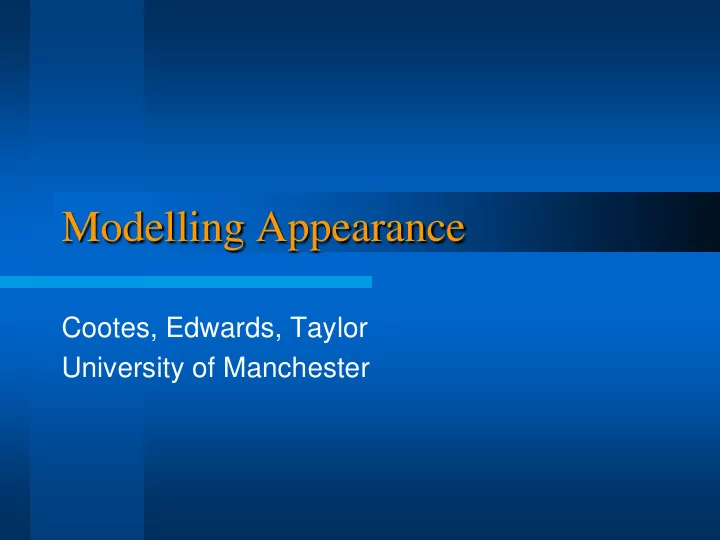

Modelling Appearance Cootes, Edwards, Taylor University of Manchester
Lessons learned ASM is relatively fast ASM too simplistic; not robust when new images are introduced May not converge to good solution Key insight: ASM does not incorporate all gray-level information in parameters
Combined Appearance Models Combine shape and gray-level variation in single statistical appearance model Goals: – Model has better representational power – Model inherits appearance models benefits – Model has comparable performance
How to generate a AAM Label training set with landmark points representing positions of key features Represent these landmarks as a vector x Perform PCA on these landmark vectors
Appearance Models Statistical models of shape and texture Generative models – general – specific – compact (~100 params)
Building an Appearance Model Labelled training images – landmarks represent correspondences
Building an Appearance Model For each example Shape: x = ( x 1 ,y 1 , … , x n , y n ) T Texture: g Warp to mean Raster shape Scan
Building an Appearance Model Principal component analysis = + – shape model: x x P s b s = + g g P g b – texture model: g Columns of P r form shape and texture bases Parameters b r control modes of variation
Shape and Texture Modes Shape variation (texture fixed) Texture variation (shape fixed)
Combined Appearance Model Shape and texture may be correlated b Q x x s = + x – PCA of c b Q g g g g Varying appearance vector c
Colour Appearance Model c 1 c 2 c 3
AAM Properties Combines shape and gray-level variations in one model – No need for separate models Compared to separate models, in general, needs fewer parameters Uses all available information
AAM Properties (cont.) Inherits appearance model benefits – Able to represent any face within bounds of the training set – Robust interpretation Model parameters characterize facial features
AAM Properties (cont.) Obtain parameters for inter and intra class variation (identity and residual parameters) – “explains” face
AAM Properties (cont.) Useful for tracking and identification – Refer to: G.J.Edwards, C.J.Taylor, T.F.Cootes. "Learning to Identify and Track Faces in Image Sequences“. Int. Conf. on Face and Gesture Recognition, p. 260-265, 1998. Note: shape and gray-level variations are correlated
AAM Search •Features •Identity •Expression Model Parameters •Pose •Lighting
Practical Applications
Face Tracking Original Tracking
Car Model Main Mode of Variation Original Search
MR Brain Slice Combined Mode 1 Combined Mode 2
MR Brain Slice - Search
MR Knee Cartilage
Summary Generic approach - analysis by synthesis Robust image interpretation Labelled structure – segmentation, measurement Recognition – parametric description Practical applications
Constrained AAMs Model results rely on starting approximation Want a method to improve influence from starting approximation Incorporate priors/user input on unseen image – MAP formulation
Constrained AAMs Assume: – Gray-scale errors are uniform gaussian with variance – Model parameters are gaussian with diagonal covariance – Prior estimates of some of the positions in the image along with covariances
Constrained AAMs (cont.) We get update equation: where:
Constrained AAMs Comparison of constrained and unconstrained AAM search
Conclusions Combined Appearance Models provide an effective means to separate identity and intra- class variation – Can be used for tracking and face classification Active Appearance Models enables us to effectively and efficiently update the model parameters
Conclusions (cont.) Approach dependent on starting approximation Cannot directly handle cases well outside of the training set (e.g. occlusions, extremely deformable objects)
End www.isbe.ac.uk
Recommend
More recommend